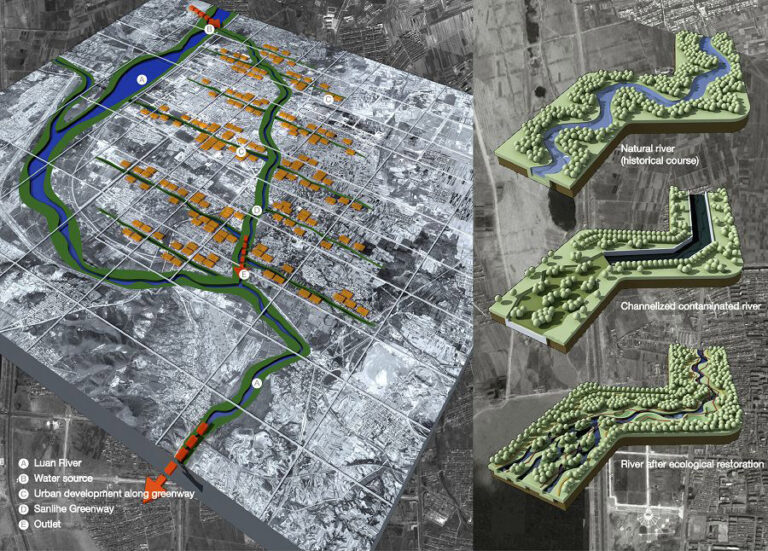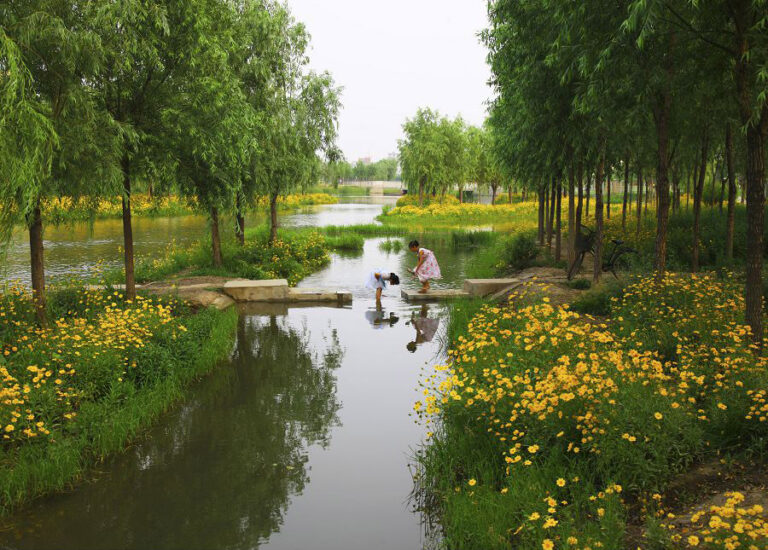In artificial urban environments, it is crucial to leave space for nature.There are many advantages to creating urban ecological corridors in urban areas. By connecting isolated areas of natural habitat and acting as green networks, these corridors facilitate the migration of species. They increase the resilience of urban ecosystems by encouraging biodiversity by letting plants, animals, and insects to migrate, reproduce, and distribute seeds. Ecological corridors reduce pollutants and provide green zones for carbon sequestration, which help enhance air quality.
By giving locals and visitors access to the outdoors and recreational activities, they improve urban aesthetics. These corridors can also aid with temperature control, reduce the impact of urban heat islands, and control stormwater runoff, all of which help with climate adaptation and resilience. Ecological corridors promote a harmonious coexistence between urban growth and the natural environment by integrating nature into urban areas, enhancing the general well-being and quality of life of city residents.
I appreciate you providing us with a thorough overview of the planning, factors, and tactics involved in creating ecological corridors. I found your article to be helpful because, as a student with a background in urban planning, I frequently encounter design projects that prioritise the built environment at the expense of its ecological context.
Building ecological corridors in cities
Biodiversity and its functions and services in cities are the basis for human health and well-being, economic growth, and sustainable social development. However, several factors, such as overexploitation and invasive alien species, seriously threaten global biodiversity. [1]
Objectives
Urban ecological corridors are ecological pathways that connect the natural urban landscape with wildlife habitats, to protect and restore the urban natural environment and provide places for people to get closer to nature, recreation, fitness, and exercise. The construction of urban ecological corridors is an important direction in today’s urban planning and environmental protection work.
Establishing new urban ecological corridors
Protecting urban ecological zones and providing ecological substrates
Through ecological background cognition, ecological element identification, and ecological environment analysis, the ecological base is assessed, important ecological patches are preserved, site contours are sorted out, and a structural framework of green space systems is established to provide a habitat substrate for new urban areas and lay the foundation for their biodiversity. [2]
For example, the quality of the environment along the route, the layout of roads and buildings, the installation of facilities, and the planting of trees and plants along the route need to be considered. To ensure that the urban ecological corridors can truly play a role in ecological protection and landscape beautification, we need to focus on the protection and restoration of the ecological environment during the planning and construction process, such as the reasonable installation of vegetation, the construction of pedestrian and bicycle paths, and the strengthening of waste treatment and environmental monitoring along the routes.
Ecological network construction to safeguard ecological diversity
Based on the establishment of habitat substrates, the types of habitat systems are identified and classified, mainly including woodland habitat systems, grassland habitat systems, wetland habitat systems, field habitat systems, etc. Biodiversity surveys are carried out for each type of habitat system, and on this basis plant diversity is configured to provide habitats and ecological steppingstones for animals, gradually forming stable ecological communities of plants and animals, and ultimately forming the biodiversity of the urban Biodiversity in the new area. [2]
The construction of urban ecological corridors requires a certain degree of sustainability. This means that the costs of operating and maintaining the corridor, as well as the views and participation of the communities along the corridor, need to be considered during the construction process. At the same time, the construction of urban ecological corridors needs to follow ecological principles, such as maintaining the diversity of the natural landscape, protecting wildlife habitats, and reducing carbon emissions, to achieve a harmonious coexistence between the city and nature.
Case in point
In the country where I live, one city has integrated land development and ecology, using a combination of landscape and ecological infrastructure to improve a forgotten area. A walking and cycling system was created, incorporating traditional local features. Social identity has been enhanced. Promotes sustainable urban development in the area. Integrates stormwater management, vegetation restoration, and creative arts and stimulates urban development. Creates ecological wetlands in the main waterways through the use of resilient green river strategies to control flooding, manage urban stormwater runoff, act as a ‘green sponge’, and create diverse wildlife habitats.

Fig1: Models of ecological corridors and their transformation process Copyright ©️ gooood https://www.gooood.cn/qian-an-sanlihe-greenway-turen.htm

Fig2: The picture shows the site as it was in 2006 Copyright ©️ gooood https://www.gooood.cn/qian-an-sanlihe-greenway-turen.htm


Fig3: Upstream area of the ecological corridor Copyright ©️ gooood https://www.gooood.cn/qian-an-sanlihe-greenway-turen.htm
Fig4: Water-friendly interaction Copyright ©️ gooood https://www.gooood.cn/qian-an-sanlihe-greenway-turen.htm
Future and Vision
In conclusion, the construction of urban ecological corridors is an effective way to protect the urban ecological environment, providing more places for urban residents to experience nature and recreation, as well as improving the ecological quality of the city and achieving a harmonious coexistence between the city and nature. In future urban planning and construction, we need to pay more attention to the construction of urban ecological corridors and strengthen the cooperation between the government and society, to jointly create a better future for the city and nature.
Reference
[1] Jiang Yanlin, Ma Xiaoyan, and Feng Li. “Advances in biodiversity research in the urban wilderness.” Hunan Journal of Ecological Sciences (2022).
[2] Ji Ye. “Biodiversity design response for new urban areas from the perspective of ecological civilization – an example of urban design for the core area of Xiaoxiang New Town in Dianzhong New District.” Urban Architecture 19.10(2022):3.



In artificial urban environments, it is crucial to leave space for nature.There are many advantages to creating urban ecological corridors in urban areas. By connecting isolated areas of natural habitat and acting as green networks, these corridors facilitate the migration of species. They increase the resilience of urban ecosystems by encouraging biodiversity by letting plants, animals, and insects to migrate, reproduce, and distribute seeds. Ecological corridors reduce pollutants and provide green zones for carbon sequestration, which help enhance air quality.
By giving locals and visitors access to the outdoors and recreational activities, they improve urban aesthetics. These corridors can also aid with temperature control, reduce the impact of urban heat islands, and control stormwater runoff, all of which help with climate adaptation and resilience. Ecological corridors promote a harmonious coexistence between urban growth and the natural environment by integrating nature into urban areas, enhancing the general well-being and quality of life of city residents.
I appreciate you providing us with a thorough overview of the planning, factors, and tactics involved in creating ecological corridors. I found your article to be helpful because, as a student with a background in urban planning, I frequently encounter design projects that prioritise the built environment at the expense of its ecological context.